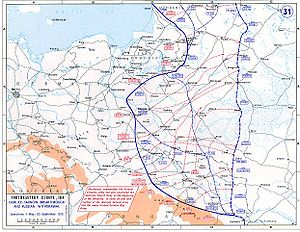Gorlice–Tarnów Offensive
| Gorlice–Tarnów Offensive | |||||||
|---|---|---|---|---|---|---|---|
| Part of the Eastern Front of World War I | |||||||
 Gorlice–Tarnów breakthrough and Russian withdrawal |
|||||||
|
|||||||
| Belligerents | |||||||
|
|
|
||||||
| Commanders and leaders | |||||||
|
|
|
||||||
| Units involved | |||||||
|
|
|
||||||
| Strength | |||||||
| Unknown | Unknown | ||||||
| Casualties and losses | |||||||
|
German Empire: unknown |
2 May – 22 June: |
||||||
Central Powers victory
German Empire:
2 May – 22 June:
87,000 killed, wounded, and missing
2 May – 22 June:
Total: ~550,000
250,000 captured
~300,000 killed and wounded
The Gorlice–Tarnów Offensive during World War I was initially conceived as a minor German offensive to relieve Russian pressure on the Austro-Hungarians to their south on the Eastern Front, but resulted in the Central Powers' chief offensive effort of 1915, causing the total collapse of the Russian lines and their retreat far into Russia. The continued series of actions lasted the majority of the campaigning season for 1915, starting in early May and only ending due to bad weather in October.
In the early months of war on the Eastern Front, the German Eighth Army conducted a series of almost miraculous actions against the two Russian armies facing them. After surrounding and then destroying the Russian Second Army at the Battle of Tannenberg in late August, Paul von Hindenburg and Erich Ludendorff wheeled their troops to face the Russian First Army at the First Battle of the Masurian Lakes, almost destroying them before they reached the protection of their own fortresses as they retreated across the border.
When these actions petered out in late September, much of two Russian armies had been destroyed, and all Russian forces had been ejected from the Masurian Lakes area of modern north-east Poland after losing almost 200,000 killed or captured soldiers.
The Russians did far better in the south where they faced the Austro-Hungarians, who mobilized more rapidly and started their own offensive in late August from Galicia, their province in partitioned Poland, initially pushing the Russians back into what is now central Poland. However, a well-executed Russian counter-stroke in late September, when they had brought more men to the front, pushed their enemy back over their own borders in disarray, leaving a large garrison besieged in the fortress city of Przemyśl.
...
Wikipedia
